Results 431 to 440 of 503
Thread Information
Users Browsing this Thread
There are currently 1 users browsing this thread. (0 members and 1 guests)
-
02-08-2024, 03:35 AM #431
Copycat Dolly Parton's Stampede Soup (small batch)
THURSDAY 8 FEBRUARY 2024
Today I am sharing a copycat recipe for Dolly Parton's Stampede Soup. I found the recipe on Dinner 321. It looked simple to make and delicious. I like simple and delicious. That is just how I roll if possible.
I had more than enough complicated cooking when I cooked at the Manor. In my retirement I no longer want to work my fingers to the bone unless I really have to. I can do it if required, but I prefer not to if I don't have to!
Subscribe to The English Kitchen!
Supposedly this is a copycat recipe which is said to taste very much like Dolly's at the Dixie Stampede. I have never been there so I cannot say for sure. I am a huge fan of Dolly's and have been since I was a girl.
But I have never travelled into the states any further south than Boston. I used to wish I could go to Nashville, but I think my travelling days are long over. I no longer have wander-lust in my bones.
When I was growing up I used to dream about travelling the world. We had an Encyclopedia that had Geography books included with it. I used to devour them and dream about visiting all of the places in its pages.
My parents could not afford to take us travelling. We did not get to go on summer holidays like some families did. I remember the people next door to us having a station wagon and there were travel decals on the back windows of all the places they had travelled to.
I spent a lot of time ogling those decals and thinking about all of the fantastic things they might have seen! My favorite one was the one from Disney World. Oh how I would have loved to have been able to go to Disney World! That would have been a dream come true.
As an adult I have travelled quite a bit and I have enjoyed all of my travels, but most of them have been on the other side of the pond! In any case, this is a delicious soup. I did take the liberty of small-batching it so that it only makes 2 hearty servings. Simply double it if you want more!
WHAT YOU NEED TO MAKE COPYCAT DOLLY PARTON'S STAMPEDE SOUP
Very simple ingredients and not a lot of them. The vegetables can be easily adapted to whatever cooked vegetables you have to hand. I love recipes like this!
- 2 TBS (29g) butter
- 2 TBS (16g) all purpose, plain flour
- 1/2 tsp garlic powder (not salt)
- 1/2 tsp onion powder (not salt
- 1/4 tsp white pepper
- 1/4 tsp kosher salt
- 8 ounces (1 cup/240ml) good quality chicken stock
- 1/2 (15 oz/425g) tin of mixed vegetables, drained (save the other half for another purpose.)
- 1/2 cup (120ml) whole milk
- 1/2 cup (120ml) heavy cream
I used salted butter as that is the only butter I keep in my house. I still had to add a bit of salt at the end. It all depends I suppose on how salty you like things. My chicken stock was not overly salty either.
Do make sure you use garlic and onion powders and not the salts. The powders give you much more flavor without adding excess saltiness.
I am sure that black pepper would work as well as white pepper. I like the distinct flavor of white pepper and am quite happy to use that.
You can use any cooked vegetable. A can of veg-all drained works, as do cooked frozen vegetables, or any leftover cooked vegetable that you happen to have on hand.
The original recipe called for half and half. I did not have any of that. I think it is what is called single cream in the U.K. I used half milk and half heavy cream and the results were delicious.
HOW TO MAKE DOLLY PARTON'S STAMPEDE SOUP (COPYCAT)
This has to be one of the easiest soups to make. It went together in a flash and I was eating it within 15 minutes tops! I love it when that happens!
Melt the butter in a medium saucepan over medium heat. Whisk in the flour, garlic and onion powders, white pepper and salt. Cook and stir for about a minute.
Whisk in the chicken stock, whisking constantly. Cook until the mixture bubble and thickens. Add the vegetables and simmer on low for 5 minutes.
At the end of that time mash the vegetables into the soup with a potato masher to give you your desired consistency. Whisk in the milk and the cream. Heat through until hot, again over medium heat, about 5 minutes.
Serve hot with your favorite soup side. Crackers, bread, biscuits, rolls, etc. I enjoyed mine with buttered homemade cheddar cheese bread and a healthy grinding of black pepper on top!
I only mashed my vegetables up coarsely. I like a bit of texture in my soup. You could also use an immersion blender and blitz it, but like I said, I wanted texture.
I used a can of mixed vegetables which had corn, carrots and green beans in it. You could cook your vegetables from scratch and use those, or use any leftover cooked vegetable that you have in the refrigerator. You could also add cooked pasta or rice to make it even heartier!
Never having been to Dolly's Dixie Stampede and eaten the soup there, I cannot say for sure if this tastes like the original or not. What I can tell you is that it was very simple and easy to make and it was delicious!
I enjoyed a nice hot bowl of it for my lunch along with a slice of buttered homemade Cheddar Cheese Bread and I was in soup and bread heaven! Cornbread would also be very nice with this as would a tasty buttermilk biscuit!
You can't beat a hot bowl of soup on a cold winter's day for comfort. Here are some other favorites of mine that are equally as simple to make!
QUICK AND EASY TOMATO BISQUE - Richer than regular tomato soup and a lot thicker, this makes for a deliciously hearty meal option. It is a great quick & easy soup to serve with grilled cheese sandwiches. I love to top it with croutons and a sprinkling of shredded cheddar cheese.
SIMPLE SCOTTISH TATTIE SOUP - This recipe is a huge testimony to Scottish thrift and their ability to make something incredibly tasty out of next to nothing. This is one very delicious pot of soup! Its also very economical, quick and easy to make!
Yield: 2 servings
Author: Marie Rayner
Print
Dolly Parton's Stampede Soup (small batch)
Prep Time: 5 MinCook Time: 10 MinTotal Time: 15 Min
A rich and delicious copycat recipe that takes very few ingredients and is on the table in less than 15 minutes. This is a rich, creamy and incredibly tasty soup!
INGREDIENTS
- 2 TBS (29g) butter
- 2 TBS (16g) all purpose, plain flour
- 1/2 tsp garlic powder (not salt)
- 1/2 tsp onion powder (not salt
- 1/4 tsp white pepper
- 1/4 tsp kosher salt
- 8 ounces (1 cup/240ml) good quality chicken stock
- 1/2 (15 oz/425g) tin of mixed vegetables, drained (save the other half for another purpose.)
- 1/2 cup (120ml) whole milk
- 1/2 cup (120ml) heavy cream
INSTRUCTIONS
- Melt the butter in a medium saucepan over medium heat. Whisk in the flour, garlic and onion powders, white pepper and salt. Cook and stir for about a minute.
- Whisk in the chicken stock, whisking constantly. Cook until the mixture bubble and thickens. Add the vegetables and simmer on low for 5 minutes.
- At the end of that time mash the vegetables into the soup with a potato masher to give you your desired consistency.
- Whisk in the milk and the cream. Heat through until hot, again over medium heat, about 5 minutes.
- Serve hot with your favorite soup side. Crackers, bread, biscuits, rolls, etc.
All rights reserved The English KitchenDid you make this recipe?
Tag @marierayner5530 on instagram and hashtag it #TheEnglishKitchen
Created using The Recipes Generator
This content (written and photography) is the sole property of The English Kitchen. Any reposting or misuse is not permitted. If you are reading this elsewhere, please know that it is stolen content and you may report it to me at: mariealicejoan at aol dot com
Thank you so much for visiting! Do come again!
Recommended
Cheesy Potato & Baked Bean Pie
Chicken & Dumpling Casserole for Two
Caramel But
Copycat Dolly Parton's Stampede Soup (small batch) | The English Kitchen
If you're gonna fight, fight like you're the third monkey on the ramp to Noah's Ark... and brother its starting to rain. Join our efforts to Secure America's Borders and End Illegal Immigration by Joining ALIPAC's E-Mail Alerts network (CLICK HERE)
-
02-09-2024, 06:42 PM #432
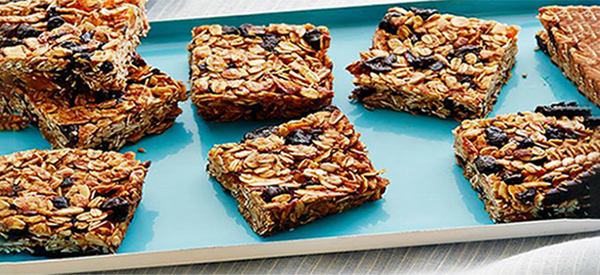
13 Survival Foods You Should Always Have at Home
by ASHLEY HETRICK
February 23, 2018

Most of us have heard that the average American has less than 3 days worth of food at home. That means we’re only 72 hours away from a food riot should supply lines be disrupted. Even if you don’t have the money on hand to invest in food storage, there are certain foods you should always keep on hand to form the basis of your survival meals.
Baby Formula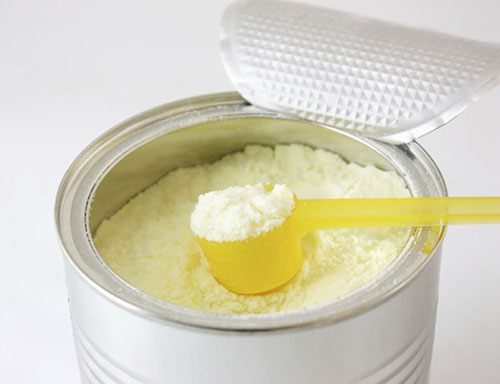
Really? Even if you don’t have babies? Yes!
Baby formula is designed to be everything a body needs to survive. Infants live exclusively on formula. No water. No solid food. Nothing else.
Powdered infant formula tastes a whole lot better than powdered milk, and it’s better for you. Dried and sealed, infant formula lasts for years.
Related: How To Choose, Use & Store Protein Powder for Preppers
Beyond that, if you’re planning to survive for the long haul, you never know when there may be an infant that needs tending. While breastfeeding is an obvious solution, there are many reasons why that might not be possible.
If you’re storing formula powder, make sure you use clean or sterilized water to reconstitute it.
If you’re adamantly against baby formula for whatever reason, consider protein powder. It wont help you feed infants, but it’s nearly as versatile when it comes to feeding adults and older children.
White Flour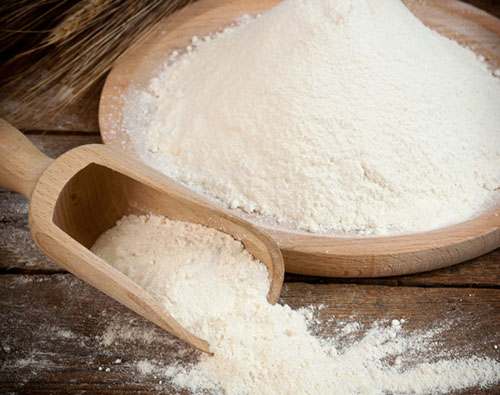
White flour lasts for a year, and has a surprising amount of protein. While historically, people living on a mostly white flour diet had trouble with nutritional deficiencies, modern flour has vitamins and minerals added to it.
Related: How to Make Acorn Flour
With a little know how, all you need is white flour, water and salt to make good bread using wild yeast.
Coconut Oil
Along with white flour, a ready source of fat will go a long way to boost moods and fill stomachs. Coconut oil has a long shelf life, and manufacturers say it should be good as the day it was bought for 2 years. Practically speaking, it’s good much longer than that, and you likely wont notice a difference if you’re eating 5 year old coconut oil that’s been properly stored.
Unlike many other types of oil, coconut oil has the added benefit that it’s tasty even if you don’t have facilities for cooking. Mash in a bit of sugar and coco powder and you’ve got yourself coconut oil truffles for comfort food and a ready source of energy, no cooking required.
Salt
Salt is often touted as a survival food, but in reality you don’t actually need to eat much salt to survive. Very small amounts will keep you healthy, and you’ll need to learn to adjust from our modern salt heavy diet.
The real reason to keep salt is for food preservation. If you happen to be lucky enough to acquire fresh meat, salt is the only thing you need to keep it from spoiling. Charcuterie is the art of preserving every part of the animal with little more than salt and technique, and transforming it into something spectacular in the process.
Before you find yourself in a survival situation, learning the basics of preserving meat without refrigeration could mean the difference between surviving and thriving.
In a pinch, cover the meat in salt. A lot of salt. Cover it completely and keep it covered. It may not quite be the same as prosciutto, but it wont spoil.
Home-Canned Fruits, Vegetables & Meats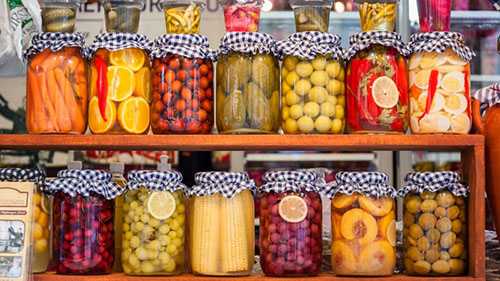
You’ll notice I say “home canned” rather than purchased. Why?
Because once you open up a can of home canned hamburger, pasta sauce or potatoes, you still have something very valuable: a canning jar.
Beyond that, if you canned them yourself you also have the knowledge to do it again. Store bought canned food will get you through the short term emergency, but the knowledge and equipment to refill those jars will carry you through the long haul.
If you’re going to spend money buying food, my personal preference would be dried fruit and meat. Dried fruits and meats are light and portable, and keeping a store of water and dried fruits is much more versatile than a store of canned foods.
Beyond that, in a cold climate, canned foods may freeze and blow their seals unless keeping the storage room climate controlled. I’d rather focus on keeping my family warm than having to worry about keeping the food at a good temperature at the same time.
Canned food is handy in many situations, because it’s instant. You can open up a can and eat it as is with no preparation. That convenience alone is worth keeping canned food around. But for the best use of my dollar, if I’m going to store canned food, it’s canned food that I’ve put up myself at little cost. Also, here are 14 must-have canned foods you didn’t know existed.
Dried Fruits and Meat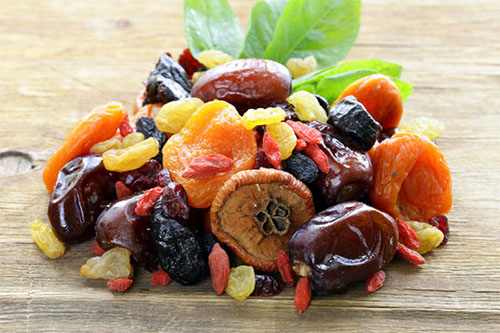
As I’ve said, dried fruits and meats are versatile. They can be eaten out of hand or boiled along with other foods into a stew if you have cooking facilities. They’re light and travel well in an emergency.
Dried fruits in particular will help keep your digestive system healthy in a crisis. If your diet is otherwise nothing more than white flour and emergency survival foods, having raisins or prunes around to keep things moving along will make everyone a lot happier and healthier.
Related: 7 Super Cheap Foods To Stockpile That People Usually Throw Away
Peanut Butter
Not only is peanut butter a comfort food, it’s also full of protein and healthy fats that will keep you satisfied long after a meal. It can be eaten right out of the container for a quick energy boost, and fully sealed containers last for years on the shelf.
Vitamins
Nutritional deficiency can destroy your health. In lean times, our ancestors had to contend with not only feeding themselves, but ensuring a balanced enough diet to prevent debilitating deficiencies.
A single cheap bottle of multi-vitamins can balance out nutritional gaps, and allow you to focus on calories rather than vitamin content. Most vitamin brands have way more than the recommended daily amount of most key vitamins, so even a single vitamin per week per person can mean a dramatic improvement to their health.
Granola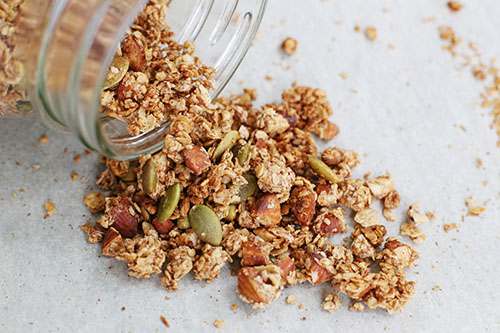
There are a lot of shelf stable snack foods. Why go with granola?
It’s high calorie, with roughly 700 calories per cup, and at the same time it’s nutritionally balanced. The mix of whole grains, nuts and sugars mean that granola is a complete meal that you can eat while on the move.
Granola also has a long shelf life, and it’s light and portable.
Dry Beans & Rice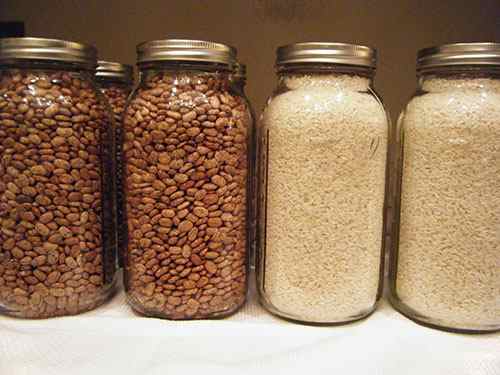
I’m calling this a single item, because you should always keep both beans AND rice. Together they form a complete protein and the contents of a 5 gallon food storage bucket can feed you for a month for about $20. Assuming you have the fuel to cook, there’s no better way to store calories and nutrition than a balance of beans and rice.
Sugar
With a grocery store just around the corner, sugar is cheap and readily available. For now. In an emergency, sugar is a excellent source of energy and it’ll be scarce without global trade.
Sugar can also be used in food preservation, which will expand your foraging options.
You may also like:
How To Make Delicious Lard With 2 Years Shelf-Life (+ 5 Tasty Recipes)
9 Food Items to Hoard (video)
Find Out What Areas Would Be Targeted by FEMA When SHTF (they’ll take your supplies)
How To Store Six Months of Food When You Only Have Space for One
13 Survival Foods You Should Always Have at Home - Ask a Prepper
If you're gonna fight, fight like you're the third monkey on the ramp to Noah's Ark... and brother its starting to rain. Join our efforts to Secure America's Borders and End Illegal Immigration by Joining ALIPAC's E-Mail Alerts network (CLICK HERE)
-
02-17-2024, 10:27 PM #433

The Key To Fighting Cancer: Eat The Creator’s Foods w/Kate Shemirani & Fiona Shakeela Burns (Video)
The Key To Fighting Cancer: Eat The Creator’s Foods w/Kate Shemirani & Fiona Shakeela Burns (Video)
Saturday, February 17, 2024 17:33
In this episode, Nurse and nutritionist Kate Shemirani and Fiona Shakeela Burns join me in this episode for how Fiona beat cancer at ages 11 and 41.
Visit Fiona’s Site
You can help Kate as thanks for all the information she supplies by getting your nutritional supplies from her at the links below.
- Genesis Healing
- The Good Inside
- Contact Kate Shemirani Here
- Follow Kate on Twitter
- Join The British Nursing Alliance On Telegram
- Kate’s grounding mat
- LifeWave
- Tropic Skincare
- Vitamin B17
Video The Key To Fighting Cancer: Eat The Creator's Foods w/Kate Shemirani & Fiona Shakeela Burns (rumble.com)
- Activate Your Own Stem Cells & Reverse The Aging Process – Choose “Select & Save” OR Join, Brand Partner & Select Silver To Get Wholesale Prices
- Get your Vitamin B17 & Get 10% Off With Promo Code TIM
- How To Protect Yourself From 5G, EMF & RF Radiation
- Protect Your Income & Retirement Assets With Gold & Silver
- Grab This Bucket Of Heirloom Seeds & Get Free Shipping With Promo Code TIM
- Here’s A Way You Can Stockpile Food For The Future
- Stockpile Your Ammo & Save $15 On Your First Order
- Preparing Also Means Detoxifying – Here’s One Simple Way To Detoxify
Articles, links mentioned in this episode.
If you're gonna fight, fight like you're the third monkey on the ramp to Noah's Ark... and brother its starting to rain. Join our efforts to Secure America's Borders and End Illegal Immigration by Joining ALIPAC's E-Mail Alerts network (CLICK HERE)
-
02-21-2024, 01:20 AM #434
Enjoy that cup of joe: Here are some science-backed health benefits of CAFFEINE
06/13/2023 // Olivia Cook // 5.1K Views
Tags: blood vessels, caffeine, cardiovascular system, coffee, diuretic, excretory system, goodfood, goodhealth, headaches, health benefits, migraine, pain relief, urination, vasoconstrictor, vasodilator

Mention caffeine and the first thing that often comes to mind is a cup of coffee. Often, a cup of joe is enjoyed in the morning. However, caffeine does so much more than keeping one awake – and here are some of its other health benefits.Caffeine contributes to pain relief
A brief literature review published March 2016 in Anesthesiology and Pain Medicine found that caffeine helps address migraine when used as an adjuvant treatment. The paper's authors noted that caffeine acts on adenosine receptors that are involved in pain sensations, and the substance is present in some over-the-counter (OTC) pain medications. It noted that caffeine possesses potential to address hypnic headache and postdural puncture headache. (Related: 5 Caffeine FACTS and 5 caffeine MYTHS.)
Caffeine helps promote urination
According to a 2010 study published in Urology Annals, caffeine is a diuretic – something that promotes increased urination and excretion of waste materials in the body. The paper stated that caffeine at 4.5 mg/kg prompted increased urination, leading its authors to note that the substance can "promote early urgency and frequency of urination." However, they warned that those with symptoms of lower urinary tract disease should be cautious when consuming foods with caffeine – if not avoiding them altogether.
Caffeine affects blood vessels differently, depending on their location
A 2017 piece by Dr. Omar Haqqani of Vascular Health Clinics in Michigan explained that caffeine affects blood vessels differently, depending on where they are located.

Caffeine causes the blood vessels in the head and neck to narrow, which helps in headaches. The rush of blood to the brain causes swelling and pressure, with the pressure translating to the pain caused by a headache. Caffeine's vasoconstrictive relieves pressure and eliminates the pain.
Meanwhile, blood vessels in other parts of the body benefit from caffeine as it widens them. This allows greater blood flow, particularly in the muscles and the lungs. This vasodilative effect of caffeine results in increased muscle performance and improves breathing.
Potential negative effects of caffeine
Caffeine occurs naturally in more than 60 plants, with coffee beans being the most ubiquitous source. But aside from coffee beans, caffeine is also present in cacao pods used to make chocolate products and kola nuts used to flavor some soft drinks, not to mention tea leaves.
Synthetic caffeine also exists, and is often used as an additive to some food items and medicines. Pain relievers, cold medicines, OTC medicines for alertness, "energy-boosting" candies and energy drinks make use of synthetic caffeine at times.
However, caffeine also has negative effects on the cardiovascular system – most especially when consumed in large amounts. Excessive caffeine consumption can cause anxiety and difficulty sleeping. It is also possible to develop caffeine tolerance; this means that larger and larger amounts are needed to achieve the same effect.
Caffeine can also raise the heart rate and trigger palpitations, due to its effect on the adrenal glands that produce the stress hormone adrenaline. When faced with danger or fear, adrenaline is produced in preparation for the body's fight or flight response. This results in increased breathing and heart rates.
These caffeine-triggered adrenaline releases – particularly large amounts of it for long periods – can weaken the heart muscle and increase the risk of a heart attack over time. Those with diabetes are susceptible to this. Moreover, excess caffeine can cause high-blood pressure or make it worse in some that already experience it.
Regular use of more than 600 mg of caffeine might cause the short-term effects listed above. Long-term effects at this level may include chronic insomnia; constant anxiety; depression; gastrointestinal issues; headaches; irritability; jitteriness; muscle tremors; restlessness; sleep problems and possible cardiac issues. Therefore, enjoy -- in moderation.
Check out Health.news for more stories about the benefits (and possible risks) of caffeine.
Watch this video about caffeine's benefits and side effects.
This video is from the Holistic Herbalist channel on Brighteon.com.
More related stories:
Caffeine withdrawals can be overcome by the power of the mind.
Long-term consumption of caffeine may worsen effects of Alzheimer’s.
How to beat caffeine addiction and lessen withdrawal symptoms.
Sources include:
PrepSchoolDaily.Blogspot.com
Brieflands.com
Journals.LWW.com
OurMidland.com
MedlinePlus.gov
Brighteon.com
Enjoy that cup of joe: Here are some science-backed health benefits of CAFFEINE – NaturalNews.com
If you're gonna fight, fight like you're the third monkey on the ramp to Noah's Ark... and brother its starting to rain. Join our efforts to Secure America's Borders and End Illegal Immigration by Joining ALIPAC's E-Mail Alerts network (CLICK HERE)
-
02-22-2024, 04:29 AM #435If you're gonna fight, fight like you're the third monkey on the ramp to Noah's Ark... and brother its starting to rain. Join our efforts to Secure America's Borders and End Illegal Immigration by Joining ALIPAC's E-Mail Alerts network (CLICK HERE)
-
02-22-2024, 04:37 AM #436If you're gonna fight, fight like you're the third monkey on the ramp to Noah's Ark... and brother its starting to rain. Join our efforts to Secure America's Borders and End Illegal Immigration by Joining ALIPAC's E-Mail Alerts network (CLICK HERE)
-
02-22-2024, 04:42 AM #437If you're gonna fight, fight like you're the third monkey on the ramp to Noah's Ark... and brother its starting to rain. Join our efforts to Secure America's Borders and End Illegal Immigration by Joining ALIPAC's E-Mail Alerts network (CLICK HERE)
-
02-22-2024, 04:59 AM #438If you're gonna fight, fight like you're the third monkey on the ramp to Noah's Ark... and brother its starting to rain. Join our efforts to Secure America's Borders and End Illegal Immigration by Joining ALIPAC's E-Mail Alerts network (CLICK HERE)
-
02-23-2024, 12:03 AM #439
Study reveals the power of COFFEE against COVID-19 infections
02/22/2024 // Ramon Tomey // 2.1K Views
Tags: biomedical research, coffee, covid-19, Cures, food cures, food is medicine, goodfood, goodhealth, goodmedicine, goodscience, infections, natural cures, pandemic, remedies, research, spike protein, superfood, superfoods, Wuhan coronavirus

Whoever thought a hot cup of joe could help address Wuhan coronavirus (COVID-19) infection? Indeed, two studies have shown the power of coffee against this pathogen.
The first study published in Cell & Bioscience last November found that drinking approximately one to two cups of coffee daily is enough to inhibit COVID-19 infections caused by different strains of SARS-CoV-2. In particular, it found that the consumption of coffee addressed infections caused by the original SARS-CoV-2 strain and its subsequent variants – the B117 alpha strain, the B16172 delta strain and the B11529 omicron strain.
The study authors from Taiwan examined coffee's ability to fight off COVID-19 infection by purchasing three kinds of coffee – ground, instant and decaffeinated – from supermarkets. They discovered that all the coffee types they scrutinized possess the ability to inhibit viral infection in cells.
The study authors also found that adding milk or sugar does not impact coffee's antiviral properties. Even decaffeinated coffee "still has the capability to interrupt SARS-CoV-2 infection, which is important to know for caffeine-sensitive populations." Moreover, they mentioned in their paper that "the optimal timeline for coffee to inhibit SARS-CoV-2 infection is within six hours" after drinking. (Related: Adding milk to coffee can help fight inflammation, suggests study.)
According to the researchers, there are two ways coffee protects human cells against SARS-CoV-2 infection. First, compounds in coffee inhibit the spike protein's ability to bind with human angiotensin-converting enzyme 2 (ACE2) in human cells. Second, they reduce the activity of transmembrane serine protease 2 (TMPRSS2) and cathepsin L (CTSL).
"Taken together, drinking one to two cups of coffee as well as decaffeinated coffee daily can potentially reduce SARS-CoV-2 infection – including wild-type, alpha, delta and omicron variants," the researchers concluded.
Same antiviral properties also present in coffee leaves
Another study by the same research team from Taiwan focused on the ability of Coffea arabica leaves to address SARS-CoV-2 infection. Their earlier study published in July 2022 in the International Journal of Biological Sciences found that C. arabica leaves can inhibit the entry of the pathogen behind COVID-19 and its various strains into human cells.
This is because C. arabica leaf extracts have several phytochemicals that are also present in coffee beans. These include chlorogenic acid, caffeine, quinic acid and mangiferin. They inhibit infection by preventing the viral spike protein from binding with ACE2 receptors in human cells and reducing the activity of TMPRSS2.
During an appearance on the Taiwanese program "Health 1+1", professor emeritus Jin-Jian Zhang of the National Taiwanese University's College of Medicine expounded on the benefits of coffee. The professor with years of research experience in coffee under his belt said daily coffee consumption can alleviate inflammation, enhance immunity, and reduce the risks of cardiovascular diseases and cancer.
According to Zhang, coffee's association with longevity is linked to the various bioactive compounds present in it – the same compounds that contribute to its antiviral properties. These compounds such as chlorogenic acid, caffeic acid, trigonelline, cafestol and melanoidins form during the roasting process, and exhibit antioxidant properties to some extent.
The professor also pointed out that coffee can help address depression, citing two mechanisms. First, coffee can increase the population of beneficial bacteria in the gut – with higher populations of good bacteria contributing to improved sleep quality. Second, the aroma of coffee beans can trigger the release of feel-good hormones in the body – enhancing overall happiness in turn.
Zhang shared that he consumes coffee with added milk, mainly to mitigate its potential effects on the digestive system. However, newer research has found that coffee with added milk offers greater benefits as the cysteine in milk combines with coffee's polyphenols, enhancing the drink's anti-inflammatory activity.
However, the professor advised against adding non-dairy creamer or sugar to coffee. Non-dairy creamer mainly contains trans fats that aren't good for the body, while sugar may contribute unnecessary calories.
Head over to CoronavirusFoods.com for more about the antiviral properties of coffee and other foods.
Watch this video about the surprising benefits of coffee.
This video is from The Truth About Cancer channel on Brighteon.com.
More related stories:
BREAKING GOOD NEWS: These four herbal extracts reduce viral load and block SARS-CoV-2, influenza, adenovirus.
Breakthrough: This fermented Japanese superfood can inhibit SARS-CoV-2 infections, researchers find.
Study shows green and black tea can inactivate several COVID-19 subvariants.
Sources include:
TheEpochTimes.com
CellAndBioscience.BioMedCentral.com
IJBS.com
Brighteon.com
Study reveals the power of COFFEE against COVID-19 infections – NaturalNews.comIf you're gonna fight, fight like you're the third monkey on the ramp to Noah's Ark... and brother its starting to rain. Join our efforts to Secure America's Borders and End Illegal Immigration by Joining ALIPAC's E-Mail Alerts network (CLICK HERE)
-
02-24-2024, 01:21 AM #440
The Best Long-Lasting Protein Sources for a Crisis
 Planning a survival stockpile can be a financial and logistical nightmare. It doesn’t take long before we realize that building that stockpile is going to be an expensive proposition. Regardless of how carefully we try to budget, it is challenging to make it work.
Planning a survival stockpile can be a financial and logistical nightmare. It doesn’t take long before we realize that building that stockpile is going to be an expensive proposition. Regardless of how carefully we try to budget, it is challenging to make it work.
For many, the financial burden of building a stockpile forces them to seek out ways of reducing their financial outlay at any cost. Unfortunately, that cost might just end up being their health, especially if they don’t stockpile the right things.
More than anything, what I see people trying to do, in order to save money, is stock up on carbohydrates, while cutting back on proteins. But both are equally important to a survival diet.
When nutritionists talk about “proper diet”, we usually hear them talking about micronutrients, things like Omega-3 fatty acids and antioxidants. Basically, things the rest of us don’t really understand. Listening to them, you might think that those micronutrients are all we need, that there is no need for macronutrients. But a survival diet has to focus on the macronutrients, even if we ignore the micronutrients.
There are three macronutrients. We need to understand what they are and what they do, in order to put a realistic survival diet together. These three nutrients are:
#1. Carbohydrates (carbs)
Simple sugars are the fuel that our bodies run on, providing the necessary energy for our body’s muscles to move.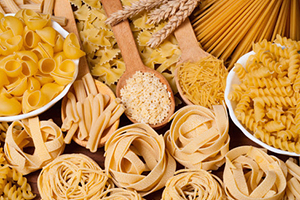
We get those simple sugars from the carbs and complex sugars that we eat (white sugar is a complex sugar).
Digestion starts in the mouth, with our teeth breaking food up and our saliva attacking those carbs and breaking them down to simple sugars. A survival diet should be 50% to 60% carbohydrates.
#2. Fats
The problem with carbohydrates is that they break down into those simple sugars quickly. Therefore are consumed quickly.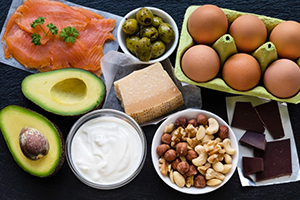
Once that happens, the individual “hits the wall” and is suddenly without energy. That’s where fats come in. They too are broken down into simple sugars, but it takes much longer than it does for carbs.
So, when the sugars from the carbs run out, the sugars from the fats take over. This gives us a one-two punch of energy. A survival diet should contain somewhere between 25% to 35% fats, mostly unsaturated fats (vegetable fats).
#3. Proteins
Of the three macronutrients, proteins are the only one we eat for a purpose other than providing energy.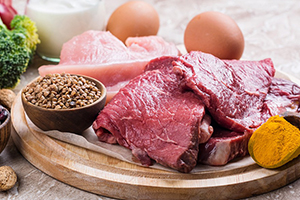
While it is possible for proteins to be broken down into simple sugars, the process is much more complex, so the body only does it in emergencies.
Rather, proteins are the basic building-blocks of life, as all cells are made up out of proteins. Even DNA, the genetic code, is made up of proteins. Since the body is constantly making new cells, it needs a constant source of proteins. If it doesn’t have it, it will cannibalize itself to get those proteins. A survival diet should contain from 10% to 20% proteins.
Selecting Your Proteins
There are two problems with proteins, from the viewpoint of building a survival stockpile. The first is that they are generally the most expensive food we buy and the second is that they are the hardest foods to preserve.
Meat, where most of our proteins come from, naturally has a higher bacterial count than any other food source. That bacteria must be killed, for the meat to successfully be preserved.
Nevertheless, these are problems that we must overcome, in order to have a healthy survival diet. Fortunately, there are many methods which have been successfully used for preserving meat for centuries, all of which are available for us today.
There are also sources of protein available to us, other than animal proteins. By mixing our stockpile so that we have both animal proteins and other food sources which contain protein, we can build a stockpile that we can afford, while providing us with the nutrition that our bodies need.
Homemade Jerky
Jerky is nothing more than spiced, dried meat. But the most important part of that jerky, besides the meat itself, is salt.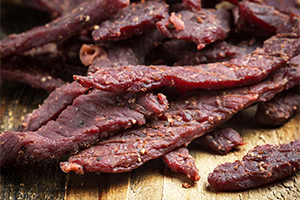
Salt is a natural preservative, and absolutely essential to making jerky safe for storage.
Making your own saves you money and gives you the opportunity to make sure that it has ample salt, so as to protect the meat. Excess salt can always be rinsed off, before use.
You also want to store homemade jerky in airtight containers, with oxygen and moisture absorbers added. The containers need to be strong enough to make it impossible for rats to chew through them and get to the meat stored inside.
Salt Fish
Salt fish is kind of the fish equivalent of jerky, made in much the same way and with a large amount of salt. If anything, salt fish has more salt used in making it, than jerky does. This preserves it well. As with jerky, you’ll probably need to make your own.
Canned Meats
Canned meat is generally cheaper than fresh cuts of meat.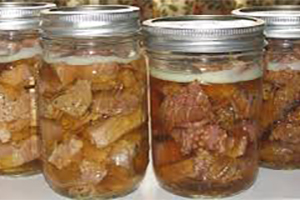
One of the reasons for this, is that canned meat is usually made from muscles of the animal which are tough and are therefore not usable for steaks and roasts.
The canning process provides ample opportunity to tenderize this meat and make it edible.
As with any other canned product, canned meats will last virtually forever. While they may not look very attractive when they come out of the can, they are nutritious and healthy to eat. Having your meat in cans also acts as portion control, helping you to ration out your food and make it last longer.
TVP (Textured Vegetable Protein)
Textured vegetable protein is a meat substitute, made purely out of plant products, mostly soy. It is made to take on the texture and flavor of different types of meat.
While it is not exactly the same texture or flavor, most people won’t recognize the difference in a casserole or other dish, if they are not told.
Beans
Beans have long been used as a source of protein. All sorts of legumes can be eaten, supplementing the protein received from animals. In many poorer cultures today, beans are the main source of protein, due to cost, rather than meat.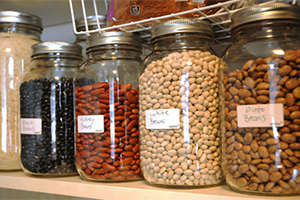
The nice thing about beans is that they are sold already dried, making it extremely easy to package them for long-term storage.
As with any other dry food, the major problem is packing them in airtight packaging, with oxygen absorbers and in a container which is strong enough to keep rodents out. That can be done by putting them in aluminized Mylar bags, inside of five-gallon buckets. Stored this way, they will keep for at least 20 years.
Nuts
Nuts have also been used as a survival protein source for centuries. In the early days of the American colonies, it was not uncommon to bury barrels and casks of nuts to preserve them for winter or other hard times. Most nuts keep well, in the shell, as long as rodents can be kept away from them.
All types of nuts can be turned into butters, not just peanut butter. They all provide a considerable amount of protein, in addition to being a comfort food.
Cheese
While cheese is harder to store for prolonged periods of time, it is possible. Actually, the making of cheese came from a desire to convert milk into storable products. Properly stored, cheese can actually last a considerable amount of time. Even when mold grows on it, the moldy edge of the cheese can be cut off, leaving perfectly good cheese for you to eat.
To preserve cheese for a prolonged period of time, triple dip it in wax (paraffin), allowing it to harden between each dipping. Check each dipping carefully, seeking for any pinholes in it, which might flow through. These must be sealed to help ensure that the cheese will keep.
Amaranth
Grains aren’t normally thought of as a good source of protein, but amaranth defies that definition. This amazing grain has 26 grams of protein per cup, the highest of any grain. It is the only grain which is considered a complete protein source, because it contains all of the essential amino acids.
Meat Products to Avoid
Sometimes, it’s not just what you do that matters, but what you don’t do. Some protein sources, especially animal proteins, may not keep for prolonged periods of time, even though they are supposedly “preserved”. You have to watch out for them.
Most of what we know as deli meats or cold cuts originated as “cured meats”. They were a way of taking meat from the animal, which may not otherwise be used, and turning it into usable meat, through the process of curing.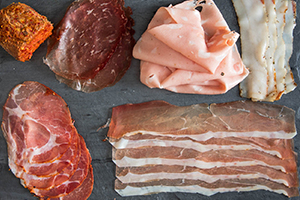
In addition to being preserved by curing, the process also serves to tenderize these meats.
The problem today though, is that what are sold as cured meats or cold cuts, aren’t cured in the same way as olden times. So they are not properly preserved and will not last for a prolonged period of time, unless you can them, in addition to being cured.
The other meat preserving process which is not done like in the olden days, is smoking. What is sold as “smoked meat” today is cold smoked to give it the smoke flavor. But it is not preserved. That requires hot smoking. So, unless you are going to hot smoke your own meats, don’t stockpile smoked meats. Even then, your hot smoked meats will not last as long as meats which are canned or made into jerky.
A Final Note About Fish
Of all the sources of food in the wild, the most abundant is fish. I don’t care where you go, you’re going to need water, and if you find water, there’s a really good chance that there will be fish swimming in it. You should always be ready to harvest those fish, providing yourself with not only food, but specifically with animal protein.
I was surprised to find out that of all the types of animal protein eaten in the world today, fish is the most common. I was expecting it to be chicken. But fish beats chicken by far. Part of that is the ready abundance of fish in the world’s oceans, providing food to us, virtually for free.
Your survival plan should include some means of harvesting whatever fish are available, wherever you are, and making them part of your diet. This means more than just having two little hooks, a bit of line and two lone weights. You need enough fishing gear to keep you fed for the long run, even considering the amount of fishing gear that often goes over the side and is lost forever.
The Best Long-Lasting Protein Sources for a Crisis – Site Title (wordpress.com)
If you're gonna fight, fight like you're the third monkey on the ramp to Noah's Ark... and brother its starting to rain. Join our efforts to Secure America's Borders and End Illegal Immigration by Joining ALIPAC's E-Mail Alerts network (CLICK HERE)
Similar Threads
-
Massachusetts Obamacare Site Tells Healthy People to Confirm Mental Diseases & Makes
By AirborneSapper7 in forum Other Topics News and IssuesReplies: 2Last Post: 11-12-2013, 04:41 AM -
Healthy Americans Health Insurance may Double, Even Triple When Obamacare Kicks In
By AirborneSapper7 in forum Other Topics News and IssuesReplies: 0Last Post: 07-01-2013, 11:48 PM -
CODEX NUTRITION COMMITTEE CHOOSES MALNUTRITION with sub-optimal nutrition
By AirborneSapper7 in forum Other Topics News and IssuesReplies: 0Last Post: 12-16-2012, 05:07 AM -
Try Parenting Instead Of Mental Health Screening
By PinestrawGuys in forum Other Topics News and IssuesReplies: 8Last Post: 02-08-2007, 04:37 PM -
Latino Diet Changes Deemed Health Crisi
By Charlesoakisland in forum illegal immigration News Stories & ReportsReplies: 12Last Post: 04-26-2005, 03:01 PM


 25Likes
25Likes LinkBack URL
LinkBack URL About LinkBacks
About LinkBacks






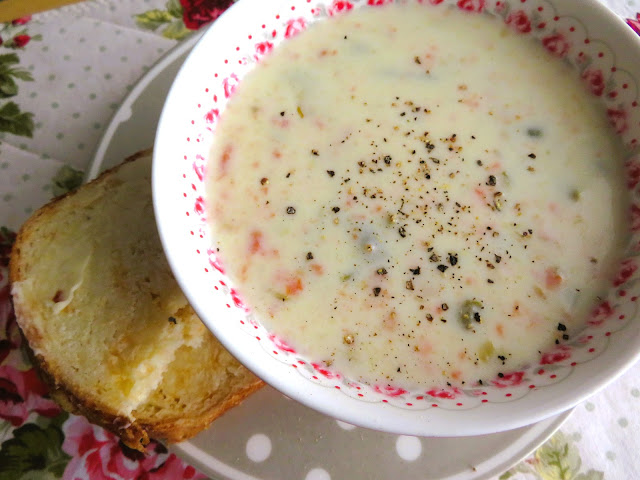
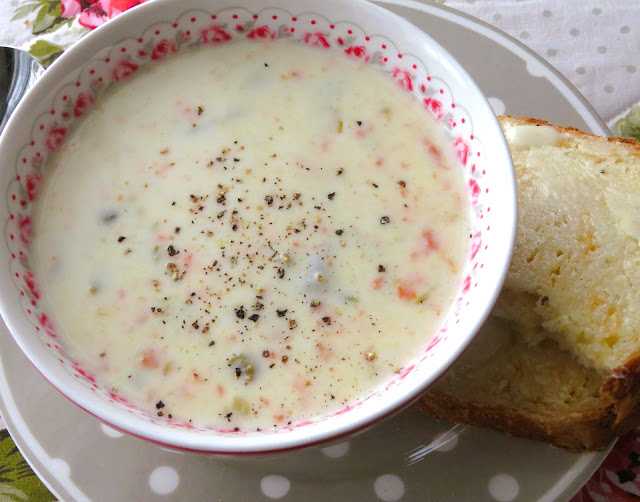


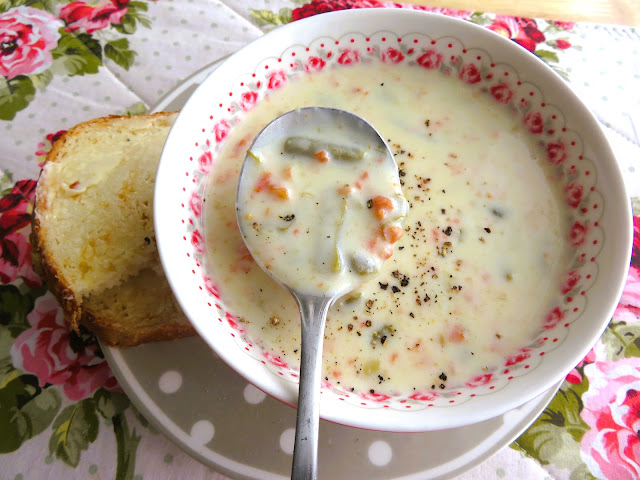









 Reply With Quote
Reply With Quote


Report: On the Southern Border Invasion by MrCati
05-08-2024, 12:17 PM in Videos about Illegal Immigration, refugee programs, globalism, & socialism